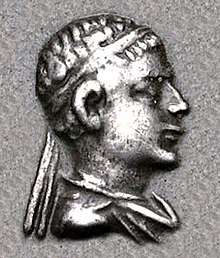Diomedes Soter
| Diomedes | |
|---|---|
 Portrait of Diomedes. | |
| Indo-Greek king | |
| Reign | 95–90 BCE |


Obv: Helmetted king Diomedes. Greek legend: BASILEOS SOTEROS DIOMEDOY "Of King Diomedes, The Saviour".
Rev: Dioscuri. Kharoshti translation of legend.

Diomedes Soter (Greek: Διομήδης ὁ Σωτήρ; epithet means "the Saviour") was an Indo-Greek king. The places where his coins have been found seem to indicate that his rule was based in the area of the Paropamisadae, possibly with temporary dominions further east. Judging from their similar portraits and many overlapping monograms, the young Diomedes seems to have been the heir (and probably a relative) of Philoxenus, the last king to rule before the kingdom of Menander I finally fragmented.
Time of reign
Bopearachchi dates Diomedes to c. 95–90 BCE and R. C. Senior dates him to c. 115–105 BCE.
Coins of Diomedes
Diomedes depicted the Dioscuri on his coins, either on horseback or standing; both types were previously used by Eucratides I. It is however uncertain how the two were related, since Eucratides I died long before Diomedes.
Diomedes minted both Attic-type coins (Greco-Bactrian style, with Greek legend only), and bilingual coins (with Greek and Kharoshthi), indicating that he was ruling in the western part of the Indo-Greek territory.
One overstrike is known, of a coin of Strato and Agathokleia over a coin of Diomedes.[1] This overstrike could indicate that Diomedes fought over the central areas of the Indo-Greek territories with Strato and Agathokleia.
See also
References
- Tarn, W. W. (1984). The Greeks in Bactria and India. Chicago: Ares. ISBN 0-89005-524-6.
- Bopearachchi, Osmund (2003). De l'Indus à l'Oxus, Archéologie de l'Asie Centrale (in French). Lattes: Association imago-musée de Lattes. ISBN 2-9516679-2-2.
External links
- Coins of Diomedes
- Other coins of Diomedes
- (in French) Le roi Diomède
| Preceded by Philoxenus |
Indo-Greek ruler in Paropamisadae 95–90 BCE |
Succeeded by Theophilos |